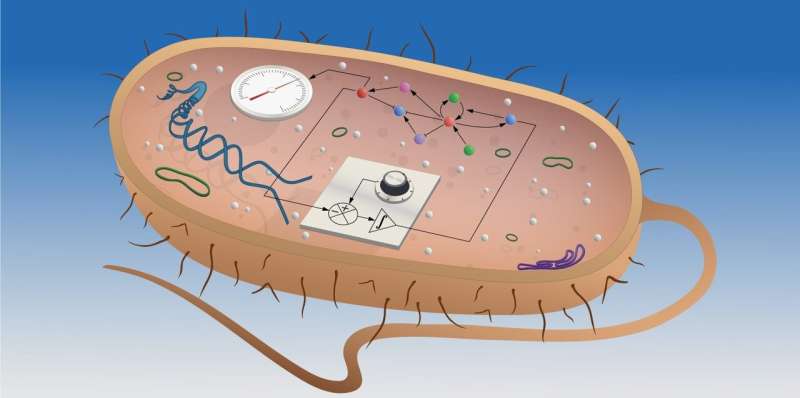Making systems robust

The human body keeps the calcium concentration in the blood constant, similarly to an aircraft's autopilot keeping the plane at a constant altitude. What they have in common is that both the body and the autopilot employ sophisticated integral feedback control mechanisms.
Researchers in the Department of Biosystems Science and Engineering at ETH Zurich in Basel have now built such an integral controller completely from scratch within a living cell, as they report in the latest issue of the journal Nature. In the future, their synthetic biology approach could make it possible to optimize biotechnological production processes and to regulate hormonal activity through cell therapy.
Constant despite environmental disturbances
Marine engineers were the first to build such an integral feedback control system, using it to automate ship steering over 100 years ago. Since then, it has been applied wherever there is a need to maintain steady, stable conditions of direction, temperature, speed or altitude in the face of outside influences. The role of integration is that it allows the control system to make corrections based on both the amount and duration of the deviation from the desired constant value.
In biology, too, mechanisms have evolved to maintain such conditions as a steady concentration of substances in the blood. Several years ago, researchers led by Mustafa Khammash, professor at the Department of Biosystems Science and Engineering, showed that these biological mechanisms are also examples of integral feedback control. "These kinds of integral controllers are extremely resistant to unexpected environmental disturbances," Khammash says, "which probably explains why the principle prevailed in evolution, and is why it is ubiquitous in technology."
Interplay of two molecules
Khammash and his interdisciplinary team of control theorists, mathematicians and experimental biologists have now engineered such an integral feedback controller in the form of a synthetic genetic regulatory network inside a bacterium. Their feedback mechanism relies on two molecules—A and B—that bind to each other to become inactive. Together, these two molecules have the ability to maintain a constant concentration of a third molecule, C. The system is designed so that molecule B promotes the production of C, while the production rate of A depends on the concentration of C. The feedback loop is such that when C is abundant, more A will be produced, which will inactivate more B, which in turn will cause production of C to fall.
As a proof of concept, the ETH scientists made use of this principle to control the production of a green fluorescent protein in Escherichia coli bacteria. Thanks to the feedback controller, the bacteria produced a constant amount of the fluorescent protein—even when the scientists, who wanted to test the system, attempted to suppress its production using strong inhibitors. In a second experiment, the researchers produced a bacterial population that grew at a constant rate in spite of the scientists' attempts to disrupt growth, again in an effort to test the feedback mechanism.
Improving biotech and therapies
Biotechnology could now put this new control mechanism to work in bacteria to produce vitamins, medications, chemicals or biofuels, with the mechanism ensuring that the production rate within the bacteria is held constant at its optimum level.
The ETH scientists are developing an analogous control mechanism for mammalian cells in subsequent research work, which will pave the way for further applications, including designer cells featuring genetic regulatory networks to produce hormones inside a patient's body. Among those who would stand to benefit from such an approach are people with diabetes or thyroid deficiency. The synthetic feedback controllers could also be used to improve cancer immunotherapy. "In this form of therapy, immune cells need to be active enough to fight the tumor, but not overactive, as they would then attack healthy tissue," Khammash says. "A mechanism like ours would be able to fine-tune their activity."
Integral controller
According to ETH Professor Mustafa Khammash, regulation of the calcium concentration in the blood is a good example with which to illustrate the principle of integral controllers in biology. This concentration is tightly regulated at a value of approximately 95 milligrams per liter of blood, regardless of how much calcium a person ingests in food. This rate even remains constant during lactation when lots of calcium is drawn from the blood in order to produce milk. "A constant level of calcium is essential to the proper functioning of many physiological processes, including muscle and nerve function or blood clotting," Khammash says.
The hormone PTH works as one of two feedback agents in the body in this context: PTH promotes the mobilization of calcium from bone tissue into the bloodstream. The lower the concentration of calcium in the blood, the more PTH is produced by the parathyroid glands. "This is one part of the body's response when the levels of calcium are too low," Khammash says.
But to bring the concentration of calcium completely back to normal after a sudden spike or drop, he adds, a second mechanism is required. This role falls to a biologically active form of vitamin D3, which promotes the absorption into the bloodstream of calcium from partially digested food in the small intestine. However, production of this active form of vitamin D3 in the kidneys is dependent on the concentration of PTH.
Together, these two hormones are responsible for ensuring that the calcium concentration in the blood over time strays as little as possible and for as short a time as possible from its normal level—or, in other words, that the "integral of deviation with respect to time," as a mathematician would put it, approaches a constant. Therefore, such a control mechanism is called integral.
More information: A universal biomolecular integral feedback controller for robust perfect adaptation, Nature (2019). DOI: 10.1038/s41586-019-1321-1 , www.nature.com/articles/s41586-019-1321-1
Journal information: Nature
Provided by ETH Zurich




















